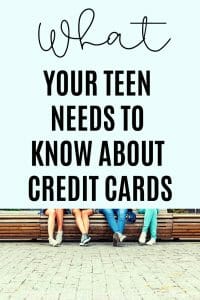How To Teach Teens About Credit Cards And What They Need To Know

How To Teach Teens About Credit Cards And What They Need To Know
So it’s my belief that credit cards and teens are generally not a good mix.
I personally don’t advocate any teen having their own credit card (at least before the age of 18 and even later if they can delay it.)
But that being said, credit cards are a staple in this world right now.
Our teens see us using credit cards and it is normalized behavior to whip at a card to pay for a purchase rather than pay cash (even though cash is still king!).
Therefore it is our responsibility to discuss with our teens when and how credit cards should be used responsibly.
One of the most trying subjects to teach your kids is how to appropriately manage money and no conversation is complete without touching upon the almighty credit card.
For the record, when I was a teen credit cards didn’t seem to exist (or maybe they did but my parents didn’t have one).
They used layaway (or layby as it’s called here in Australia) instead for any big purchases, which required that they went every few weeks to add some money to the balance.
The goal was pay off the entire balance within 12 weeks.
TRUE STORY: Amazingly I remember buying a $150 dollhouse for my daughter when she was 2 using the same layaway method and I paid it slowly over a period of three months.
It makes me feel so old saying this as I’m pretty sure the same store only offers Afterpay now (where you take the item home FIRST and then pay it off in fortnightly instalments afterwards.) No patiently waiting to save for the item first!
Here’s a quick timeline of the history of credit cards:
Credit cards were officially invented back in 1950 (the Diners Club card).
In 1955 the phrase credit card was patented and in 1959 American Express unveiled its first plastic card.
In 1970 IBM created the magnetic strip on the card to minimize fraud and in 1976 BankAmericard became Visa.
Over the years credit cards have become more and more popular to the point that it’s acceptable to go out shopping with just a credit card and nothing else.
Note: Credit cards are not to be taken lightly at any age, but especially during adolescence.
So how can you educate your older teens about the use of credit cards? These strategies will help your teens learn to use credits cards responsibly:
TEACH TEENS ABOUT CREDIT CARDS
TIP # 1 – Ask where the money will come from
Insist your teens know specifically where they’ll get the money to pay off the credit card charge before they charge anything.
A credit card DOES NOT equal FREE MONEY.
It still needs to be paid off promptly unless you want to get hit with expensive interest charges.
TEACH TEENS ABOUT CREDIT CARDS
TIP #Â 2 – Encourage responsibility
Explain that your teen is responsible for paying his or her credit card bill on time.
If your older teen insists on getting their own credit card they need to know that the goal is to pay off their credit card balance within 30 days.
Discuss with your teen how interest charges and other fees work and that paying such fees is like giving away their money for nothing.
- Take care to listen to how your teen takes part in this discussion. If you determine your teen requires more maturity or understanding of the information, encourage them to use a debit card instead (that is always my preferred option).
TEACH TEENS ABOUT CREDIT CARDS
TIP # 3 – Consider starting with a limited balance credit card
Instead of getting a credit card with a high credit limit, have your teenager save their money first until a certain amount accumulates, like $100.00.
You can then accompany them to your banking institution or store to obtain a pre-paid card for the $100.00.
- It looks like a credit card and feels like a credit card but technically the money on a prepaid card is already accounted for so no stress!
- Even though your teen has paid for the card with their own money, it’s a good idea to encourage them to make every effort to stretch out their use of the card.
A benefit of this method is that your child saved the money upfront before actually charging items.
- They can, therefore, understand that the credit card balance is tangibly their own hard-earned money.
The downside of this method is it may not teach your child the responsibility of charging only what they can pay off within the next month (but they will have plenty of time to still learn this later in life).
TEACH TEENS ABOUT CREDIT CARDS
TIP # 4 – Provide a credit card to replace weekly allowance
Consider converting their allowance to a monthly credit card balance.
This method allows them to learn about credit card management.
Consider this example:
- Let’s say you normally give your teen a $25 cash weekly allowance.
- When they turn 16, you may opt to provide them instead with a prepaid credit card rather than the $25 cash weekly.
- Explain that they can charge up to $100 per month (4 weeks times $25 equals $100) and that this amount has been covered for their credit card purchases.
- Stress that the card will no longer work if they charge over $100.
- If they are given a normal credit card to use (your choice) and they charge over $100 for the month, they need to come up with the difference.
- If not, they must surrender the credit card until they pay you the difference owed (even though you will of course go ahead and pay it off to avoid monthly fees).
- Using this method to teach your teen how to handle credit cards is a potentially helpful lesson in managing their money with limited funds. 0
Your teen learns to limit spending to stay within their means.
Teaching teens how to handle credit cards can be challenge (don’t worry it can be a challenge for some adults too).
The good news is that if you start early with your kids about how to earn, save and spend money, they’ll easily progress to understanding the above concepts with your help and guidance.
Praise your teens’ efforts when they manage their finances and credit card issues well.
You will build their confidence for the future if you teach them how to handle credit cards wisely.
If you enjoyed this post, please feel free to share it!








